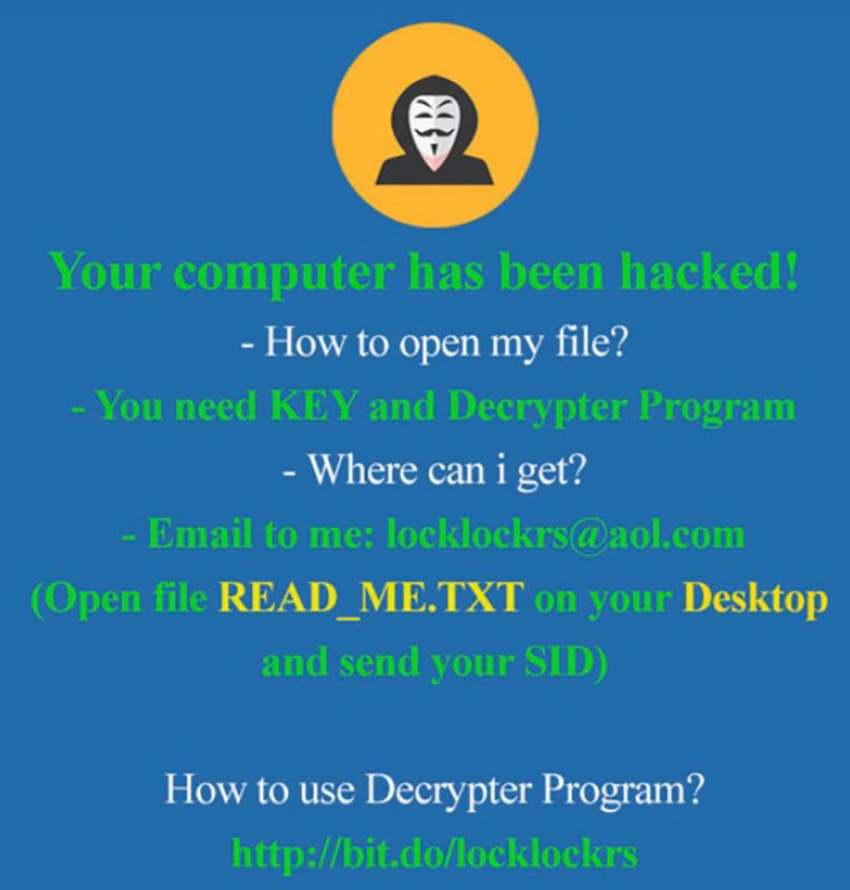LockLock Ransomware. Remove (.locklock) extension virus.
Remove locklockrs@aol.com, locklockrs malware.
LockLock Ransomware recently spotted to infect users with chinese IPs. So far victims are only from China, however judging by the ransom note this virus may start spreading worldwide. Ransomware is powerful malware (malicious software) virus that executes cryptography attack using variety of encryption algorithms. Ransomware developers simply use crypto techniques to lock victim’s files and demand ransom in return of decryption key. As victim’s data is locked, files are in on use and no longer able to open due to encryption. User files will be encrypted with AES-256 algorithm. All encrypted data can be recognised due to a ransom extension “.locklock” appended. In order to unlock files, victims will have to pay a ransom fee demanded by the ransomware developer usually in bitcoin. Ransom note will be left at victim’s desktop “READ_ME.TXT”. When opened, infected user will find instructions. Victims will also be requested to contact LockLock Ransomware developers email locklockrs@aol.com or Skype “locklockrs”, which is unusual. Apparently LockLock is based on previous open-source EDA2 Ransomware.
The ransom note “READ_ME.TXT” is as as follows:
——-> IMPORTANT INFORMATION <——-
——————————
Your Computer ID: redacted <——- Remember it and send to my email.
——————————
Your computer has been hacked!
– You need key and decrypter program
-there can i get?
-Email to me: locklockrs@aol.com
(Open file READ_ME.TXT on your desktop and send your SID)
How to use decryter program?
http://bit.do/locklockers
————– GOOD LUCK! ————–
New ransom image lock screen will be set as a background of infected computer system:

How to protect against ransomware is most frequently asked questions in the past year. Since ransomware has become the biggest threat among all viruses, people ask themselves if there’s a way to protect from such. It is already too late if you once suffered ransom attack and file has been locked. For some there is a solution but for others disappointment. Either way popularity of ransomware rises and new development are presented every day.
What can we do against the battle with ransomware?
- If you are already infected do not pay the ransom! Remove the virus and look for other solutions rather than paying. Paying the ransom may be your only option if you have really valuable data. However we do not recommend doing this because you will support the work of criminals. The risk of losing money and still stuck with encrypted files since there is no guarantee in any way that you will recover what one is lost.
- Security researcher are always working on recovery solutions. Not all ransomware are professionally developed and being cracked, but some are so good developed that there is no current way to be beaten at the current date. One of the solutions is system restore.
- Best solution is if you have a backup, wipe your hard drive and perform system restore. If not, backup your data frequently. Store backup data in any removable storage device or use any online backup services.
- Protect your computer with antivirus, internet security, anti-malware software or new developed applications like anti-ransomware. Highly recommended is to keep it up to date and use the paid surveys. We do not recommend free applications.
Now that you have been infected you have a few options:
Many suggest that you simply pay and hope that you will get all off your data back. However in this case you risk losing money and still being stuck with crypted files. We do not recommend this way simply because you will support the work of hackers and the more money thay get the stronger they will become.
The best option for you is if you have a backup, wipe your hard drive and perform system restore.
Use any type of anti malware software to remove LockLock Ransomware.
NOTE: In this option the virus will be removed but the files will remain locked! You have to decrypt your files.
New research discovery shows how ransomware deletes files and substitute encrypted copy of them. It is not guaranteed, but it is a possibility that you may recover your files with data recovery software. Before trying to decrypt any files you can scan your computer for posible data loss.
Go here to find out how to recover deleted files.
Decrypt Lock Lock Ransomware files with .locklock extension.
Good news is that we can now use decryption programs. A lot of security companies like Kasperky lab, bitdefender and more has developed a program that is fully capable of decryption key for ransomware malware. You can find this programs anywhere on the internet but it is strongly suggested to download this programs from official websites. NOTE: It may take a long time for your files to be decrypted depending on your PC performance.
- Name – Lock Lock ransomware
- Type Spamming – Malware, Ransomware, Trojan Horse
- Danger Level – High
- Brief Description – Encrypt files and demand ransom.
- Symptoms – Poor pc performance or freezing, ransom massages.
- Method – Via Trojan Horse or spam email.
Note: Removing LockLock Ransomware manually could be very risky and unpredictable!
To remove this virus we suggest you follow the step by step instructions we provided. Since ransomware virus creates variety of malicious modified registry entries and different files, we strongly advise you to use anti-malware tool. Removing the virus manually requires high computer skills and knowledge.
No Comments Yet